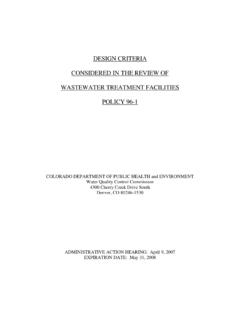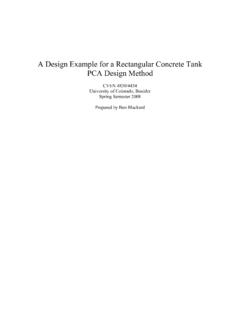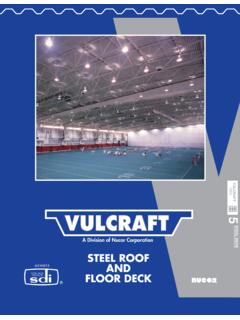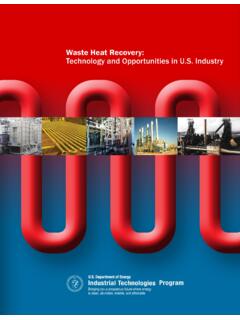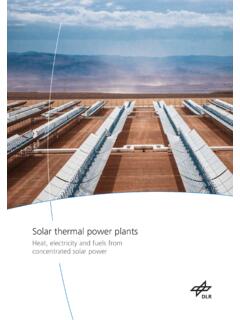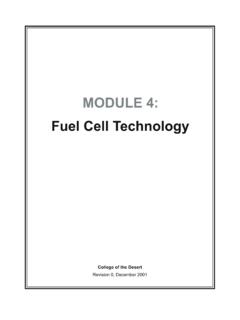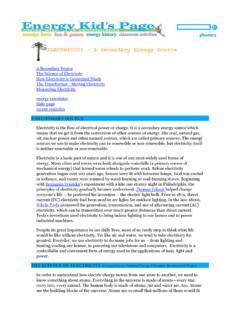Transcription of RANKINE POWER GENERATION CYCLE
1 RANKINE POWER GENERATION CYCLE A heat ENGINE: PRODUCES WORK FROM heat BY WASTING A FRACTION OF heat INPUT TO A LOW TEMPERATURE RESERVOIR T oC s (kJ/kg-K) 4 3 21 CHARACTERISTICS 1. RANKINE CYCLE is a heat engine comprised of four internally reversible processes. Significance: area enclosed by process lines equals the net heat transfer by Clausius Principle for internally reversible processes: dQ = TdS for a CYCLE : =TdSQnet and by the First Law for a CYCLE : Qnet = Wnet Wturbine + Wpump = QH + QL where Wturbine is positive, Wpump is negative, QH is positive, QL is negative, |QH| > |QL| and |Wturbine| > |Wpump|. 12. Process analysis using the First Law: Process Phases Device 1st Law expression1 2 adiabatic and reversible (isentropic) compressioninput: wpumpSaturated Liquid Compressed liquid pump wpump = (h2 h1) = v(P2 P1) 2 3 isobaric expansion qH = heat input from high temp reservoir Liquid Superheated (usually) vapor boiler qH = (h3 h2) 3 4 adiabatic and reversible (isentropic) expansion output: wturbine >> wpumpSuperheated vapor Liquid-vapor mixture (usually) turbine wturbine = (h4 h3) 4 1 isothermal and isobaric compression qL = heat rejected to low temp reservoir Liquid-vapor mixture Saturated liquid.
2 Condenser qL = (h1 h4) Note from the 1st Law expressions that in the two processes that are adiabatic and reversible (isentropic), the pump and the turbine, the only energy interaction with surroundings is work. For the two isobaric heat exchange processes, the devices are passive and there is no work, only heat transfer. 23. heat transfer in the ideal RANKINE CYCLE relies on phase change, a very efficient way to store and release energy. The working fluid is usually water/steam. During the CYCLE , the properties of the working fluid change as below with associated heat /work exchanges. h (kJ/kg) P (kPa) T (oC) s (kJ/kg-k) q or w (kJ/kg) 1 2 Small increase h1 = hf @ P1 h2 = h1 + v(P2 P1) Large Increase P2 >> P1 Negligible change T2 T1T1 = Ts @P1 Constant s1 = sf @ P1s2 = s1 Wpump < 0 wpump = (h2 h1)h2 > h1 2 3 Large increase h3 = h @ (P3,T3) Constant P3 = P2 Increase T3 > T2 Increase s3 = s @ (P3,T3) qH > 0 qH = (h3 h2) h3 > h2 3 4 Decrease h4 = x4(hfg) +hf @ (P4,T4) Large Decrease P4 < P3 Large Decrease T4 = Ts @P4 Constant s3 = s4x4 = (s4-sf)/sfg Wturbine > 0 wturbine = (h4 h3) h4 < h3 4 1 Large Decrease h1 < h4 Constant P4 = P1 Constant T4 = T1 = Ts @ P1,4 Large Decrease s1 < s4qL < 0 qL = (h1 h4) h1 < h4 4.
3 Analysis: Efficiency: [])hh()hh(1qq1QQ1)hh()hh()hh(qwQW2314 HLHL231243 HnetHnet = = = === &&&& Also, the mass flow rate can be calculated using these relations: )hh(W)hh(QqQ)hh(QqQm23net14 LLL23 HHH = == ==&&&&&& REMINDER: FOR CALCULATING , USE ABSOLUTE VALUES FOR heat AND WORK TERMS. 3 5. ENTROPY GENERATION IN RANKINE CYCLES For the CYCLE : s = 0 then = = =KkgkJT)hh(T)hh(TqTqTqsLTR41 HTR23 LTRLHTRH kkgen and =KkwsmSgengen&& where qH > 0, qL < 0, and although |qL| < |qH|, THTR >> TLTR assuring that )negative(Tq)positive(TqHTRHLTRL > and sgen > 0, making RANKINE CYCLE possible. 4 VAPOR-COMPRESSION REFRIGERATION (VCR) CYCLE FOR REFRIGERATORS AND heat PUMPS VCR TRANSFERS heat FROM A LOW TEMPERATURE RESERVOIR TO A HIGH TEMPERATURE RESERVOIR WITH WORK INPUT. T oC 4 3 2 1 s (kJ/kg-K) CHARACTERISTICS 1.
4 VCR CYCLE is comprised of three internally reversible processes. One process is actually irreversible; however, the area enclosed by the process lines can be considered to approximately indicate the net heat transfer, and the First Law for a CYCLE applies: Qnet = W = QH + QL where W is negative, QH is negative, QL is positive, and |QH| > |QL|. 5 2. Process analysis using the First Law: Process Phases Device 1st Law expression 1 2 adiabatic and reversible (isentropic) compressioninput: wcompressorSaturated Vapor Superheated Vapor compressor wcompressor = (h2 h1) 2 3 isobaric compression qH = heat rejected to high temp reservoir Superheated vapor saturated liquid condenser qH = (h3 h2) 3 4 adiabatic expansion (not isentropic.)
5 S3 s4) Saturated Liquid Liquid-vapor mixture throttling valve h4 = h34 1 isothermal and isobaric expansion qL = heat input from low temp reservoir Liquid-vapor mixture Saturated vapor evaporator qL = (h1 h4) Note from the 1st Law expressions that in the one process that is adiabatic and reversible (isentropic), the compressor, the only energy interaction with surroundings is work. For the two isobaric heat exchange processes, the devices are passive and there is no work, only heat transfer. The adiabatic throttling valve is isenthalpic, NOT isentropic, as can be seen from the T-s diagram. 63. heat transfer in the ideal VCR CYCLE relies on phase change, a very efficient way to store and release energy. The working fluid is usually refrigerant ( R-134a), a compound that boils (evaporates) at very low temperatures at near-atmospheric pressures.
6 During the CYCLE , the properties of the working fluid change as below with associated heat /work exchanges. h (kJ/kg) P (kPa) T (oC) s (kJ/kg-k) q or w (kJ/kg) 1 2 Increase h1 = hg @ P1h2 = h @ (P2,T2) Large Increase P2 >> P1 Increase T2 = T@ (P2, s1) T1 = Ts @P1 Constant s1 = sg @ P1s2 = s1 Wcompressor < 0 wcompressor = (h2 h1) h2 > h1 2 3 Large decrease h3 = hf @ P3 Constant P3 = P2 Decrease T2 > T3 Decrease s3 = sf @ (P3,T3) qH < 0 qH = (h3 h2) h3 < h2 3 4 Constant h4 = h3 x4 = (h4-hf)/hfg @ P4 Large Decrease P4 < P3 Decrease T4 = Ts @P4 Increase s3 = x4(sfg)+ sf@P4 Both 0 4 1 Large increase h1 > h4 Constant P4 = P1 Constant T4 = T1 = Ts @ P1,4 Large increase s1 > s4qL > 0 qL = (h1 h4) h1 > h4 4. Analysis: In general, the measure of VCR CYCLE performance is: Coefficient of Performance (COP) = inputworkquiredRetransferheatDesired 7 For a refrigerator (air conditioner) desired heat transfer is cooling - transfer of heat to the evaporator from the low temperature reservoir.
7 = = = ===1)hh()hh(11qq11QQ1)hh()hh(wqWQCOP4132 LHLH1241inLinLR&&&& For a heat pump desired heat transfer is heating - transfer of heat from the condenser to the high temperature reservoir. = = = ===)hh()hh(11qq11QQ11)hh()hh(wqWQCOP3241 HLHL1232inHinHHP&&&& COPHP = COPR + 1 and therefore, |qH| > |qL| Also the mass flow rate in the VCR CYCLE can be calculated using the relations: )hh(COPQ)hh(COPQ)hh(QqQ)hh(QqQm12 HPH12RL14 LLL23 HHH = = == ==&&&&&&& REMINDER: FOR CALCULATING COPR AND COPHP, USE ABSOLUTE VALUES FOR heat AND WORK TERMS. 8 ENTROPY GENERATION IN VCR CYCLES For the CYCLE : s = 0 then = = =KkgkJT)hh(T)hh(TqTqTqsLTR41 HTR23 LTRLHTRH kkgen and =KkwsmSgengen&& where qH < 0, qL > 0, and |qL| < |qH|. Also, THTR is close to TLTR assuring that )negative(Tq)positive(TqLTRLHTRH > and sgen > 0, making VCR CYCLE possible.
8 9




